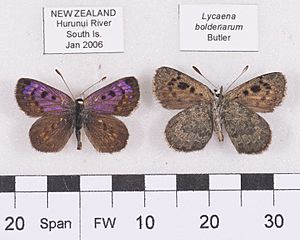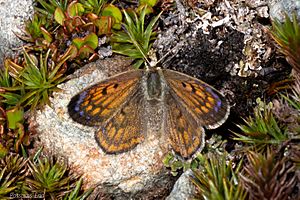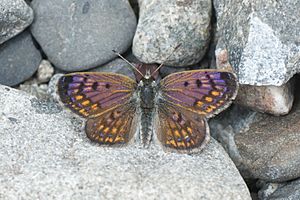Boulder copper facts for kids
Quick facts for kids Boulder copper |
|
|---|---|
 |
|
| Scientific classification | |
| Synonyms | |
|
The boulder copper (Lycaena boldenarum) is a special type of butterfly. It lives only in New Zealand, meaning it is endemic there. You can find it on both the North Island and South Island.
These butterflies like open, sunny places. They live in grasslands, rocky areas, and sand dunes. They usually fly close to the ground. The name boldenarum was given by a scientist named Adam White. He named it after his first wife, Helen, and her sister Frances, whose last name was Bolden. In the Māori language, this butterfly shares the name pepe para riki with two similar butterflies. These are the common copper (Lycaena salustius) and the glade copper (Lycaena feredayi).
Contents
Meet the Boulder Copper
The boulder copper butterfly is quite small. Its wings can spread from about 1.7 to 2.7 centimeters wide. It is the second smallest butterfly in New Zealand. The smallest is the southern blue butterfly.
The underside of the boulder copper's back wings can look very different. Some butterflies have pale, light patterns. Others have strong, dark markings on a grey background. Male boulder coppers have a shiny purple color on their upper wings. Females usually have patterns more common for Lycaena butterflies.
Where It Lives
This butterfly is found only in New Zealand. It is very common across the South Island. On the North Island, you can find it in specific areas. These include Wairarapa, the Central Plateau, and Hawke's Bay.
The boulder copper lives in many open places. These include grassy fields, areas with loose stones, and sand dunes. It also likes braided rivers, which are rivers with many small channels. Its common name, "boulder copper," does not mean it lives near big rocks. Instead, it comes from the scientific name, which honors Helen Bolden.
Life Cycle of the Butterfly
The young butterflies, called larvae or caterpillars, eat certain plants. They mostly feed on Muehlenbeckia axillaris. Sometimes, they also eat Rumex flexousus. It is possible they use other Muehlenbeckia plants too.
The female butterfly lays a single egg. She places it on a plant stem or under a leaf. The caterpillar can be different colors. It might be olive green, yellowish green, pink, or reddish brown. It always has a special diamond shape on its neck area.
When winter comes, the caterpillar stops growing. It hides under small stones. In the spring, it starts eating again. These caterpillars are often seen near Monomorium ants. However, scientists have not found a special partnership between them.
When the caterpillar is ready, it turns into a pupa. The pupa can be light brown or reddish. Both types have black spots on their body. The pupa attaches itself to a dead leaf on the ground. It uses a small hook and some silk threads to stay safe.
Different Types of Boulder Coppers
Scientists have found a few slightly different types of the boulder copper butterfly. These are called subspecies:
- Lycaena boldenarum boldenarum
- Lycaena boldenarum caerulea (Salmon, 1946)
- Lycaena boldenarum ianthina (Salmon, 1946)
Protecting a Subspecies
One of these types, Lycaena boldenarum ianthina, needs special care. Experts have classified it as "Nationally Critical." This means it is at a very high risk of disappearing from New Zealand. This classification comes from the New Zealand Threat Classification System.



